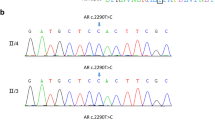Abstract
The X-linked androgen insensitivity syndrome (AIS) encompasses a heterogeneous group of defects in the androgen receptor (AR) that result in varying degrees of undermasculinization. In the current study, we characterize the R840S mutation on exon 7 of the AR ligand-binding domain. The Egyptian patient, who had been reared as female, presented ambiguous genitalia at 6.5 yr. Diagnosis of partial AIS (PAIS) was based on clinical phenotype and laboratory evidence of good testosterone response and normal testosterone/dihydrotestosterone (T/DHT) ratio. The therapeutic response to testosterone depot injections justified reassignment to male sex. To our knowledge, this mutation has been reported only once in two Brazilian brothers with PAIS. Three other mutations of this residue (R840C; R840G, nonconservative; and R840H, conservative) have been reported in patients with PAIS and, when expressed in vitro, they led to subnormal transactivation of a reporter gene. Each of these mutations was associated with a very diverse spectrum of phenotypes. These data highlight the role of the AR ligand-binding pocket (LBP) in the expression of transcriptional activity during prenatal sex differentiation.
Similar content being viewed by others
References
Suzuki K, Fukabori Y, Nakazato H, et al. Novel amino acid substitutional mutation, tuyrosine-739-aspartic acid, in the androgen receptor gene in complete androgen insensitivity syndrome. Int J Androl 2001, 24: 183–8.
Ahmed SF, Cheng A, Dovey L, et al. Phenotypic features, androgen receptor binding, and mutational analysis in 278 clinical cases reported as androgen insensitivity syndrome. J Clin Endocrinol Metab 2000, 85: 658–65.
Heinlein CA, Chang C. Androgen receptor coregulators: an overview. Endocr Rev 2002, 23: 175–200.
Quigley CA, De Bellis A, Marschke KB, El-Awady MK, Wilson EM, French FS. Androgen receptor defects: historical, clinical, and molecular perspectives. Endocr Rev 1995, 16: 271–321.
Gottleib B, Lehvaslaiho H, Beitel LK, Lumbroso R, Pinsky L, Trifiro M. The androgen receptor gene mutations database. Nucleic Acids Res 1998, 26: 234–28
Chavez B, Mendez JP, Uloa-Aguirre A, Larrea F, Vilchis F. Eight novel mutations of the androgen receptor gene in patients with androgen insensitivity syndrome. J Hum Genet 2001, 46: 560–5.
Melo KF, Latronico AC, Costa EM, Billerbeck AE, Mendonca BB, Arnhold IJ. A novel point mutation (R840S) in the androgen receptor in a Brazilian fmily with partial androgen insensitivity syndrome. Hum Mutat 1999, 14: 353.
Prader V. Volkmmen mannliche aessers Genitalentwicklung und Salverust bei Maedchen mit Kongenitalen adrenogenitale Syndrome. Helv Pediatr Acta 1958, 13: 5–14.
Lumbroso S, Lobaccaro JM, Georget V, et al. A novel substitution (Leu 707 Arg) in exon 4 of the androgen receptor gene causes complete androgen resistance. J Clin Endocrinol Metab 1996, 81: 1984–8.
Hellwinkel OJ, Bassler J, Hiort O. Transcription of androgen receptor and 5 alpha reductase II in genital fibroblasts from patients with androgen insensitivity syndrome. J Steroid Biochem Mol Biol 2000, 75: 213–8.
Miyamoto J, Hasegawa Y. Malepseudohermaphroditism due to disorder of androgen receptor function. Nippon Rinsho 2002, 60: 367–72.
Foresta C, Bettella A, Ferlin A, et al. Response to local dihydrotestosterone treatment in a patient with partial androgeninsensitivity syndrome due to a novel mutation in the androgen receptor gene. Am J Med Genet 2002, 107: 259–60.
Evans BA, Huges IA, Bevan CL, Patterson MN, Gregory JW. Phenotypic diversity in siblings with partial insensitivity syndrome. Arch Dis Child 1997, 76: 529–31
Boehmer ALM, Bruggenwirth H, Assendelet CV, et al. Genotype versus phenotype in families with androgen insensitivity syndrome. J Clin Endocrinol Metab 2001, 86: 4151–60.
Bevan CL, Brown BB, Davies HR, Evans BA, Hughes IA, Patterson MN. Functional analysis of six androgen receptor mutations identified in patients with partial androgen insensitivity syndrome. Hum Mol Genet 1996, 5: 265–73
Beitel LK, Kazemi-Esfarjani P, Kaufman M, et al. Substitution of arginine-839 by cysteine or histidine in the androgen receptor causes different receptor phenotypes in cultured cells and coordinate degrees of clinical androgen resistance. J Clin Invest 1994, 94: 546–54.
McPhaul MJ, Marcelli M, Zoppi S, Wilson CM, Griffin JE, Wilson JD Mutations in the ligand-binding domain of the androgen receptor gene cluster in two regions of the gene. J Clin Invest 1992, 90: 2097–101.
Marcelli M, Zoppi S, Wilson CM, Griffin JE, Mc Phaul MJ. Amino acid substitutions in the hormone-binding domain of the human androgen receptor alter the stability of the hormone receptor complex. J Clin Invest 1994, 94: 1642–50.
Lumbroso S, Lobacarro JM, Belon C, et al. Familial form of partial androgen insensitivity (Refenstein syndrome): arginine-histidine mutation in position 840 in the androgen receptor. CR Seances Soc Biol Fil 1993, 187: 508–15.
Imasaki K, Hasegawa T, Okabe T, et al. Single amino acid substitution (840 Arg-His) in the hormone-binding domain of the androgen receptor leads to incomplete androgen insensitivity syndrome associated with a thermolabile androgen receptor. Eur J Endocrinol 1994, 130: 569–74.
DeBellis A, Quigley CA, Marschke KB, et al. Characterization of mutant androgen receptors causing partial androgen insensitivity syndrome. J Clin Endocrinol Metab 1994, 78: 513–22
Hughes I, Patterson M. Prenatal diagnosis of androgen insensitivity. Clin Endocrinol (Oxf) 1994, 94: 295–6.
Weidemann W, Linck B, Haupt H, et al. Clinical and biochemical investigation and molecular analysis of subjects with mutations in the androgen receptor gene. Clin Endocrinol (Oxf) 1996, 45: 733–9.
Giwercman Y, Nikoshkov A, Lindsten K, et al. Functional characterization of mutations in the ligand-binding domain of the androgen receptor gene in patients with androgen insensitivity syndrome. Hum Genet 1998, 103: 529–31.
Irvine S. Is the human testis still an organ at risk? BMJ 1996, 312: 1557–8
White R, Jobling S, Hoare S, et al. Environmentally persistent alkylphenolic compounds are estrogenic. Endocrinology 1994, 135: 175–82.
Author information
Authors and Affiliations
Corresponding author
Rights and permissions
About this article
Cite this article
Mazen, I., Lumbroso, S., Abdel Ghaffar, S. et al. Mutation of the androgen receptor (R840S) in an Egyptian patient with partial androgen insensitivity syndrome: Review of the literature on the clinical expression of different R840 substitutions.. J Endocrinol Invest 27, 57–60 (2004). https://doi.org/10.1007/BF03350912
Accepted:
Published:
Issue Date:
DOI: https://doi.org/10.1007/BF03350912



